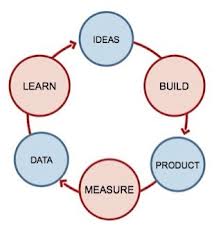If Lean Startup principals can help develop and market a product quicker, cheaper and with lower risk, then can they also help students get papers done in less time with better grades.
Back when I was studying, I tried most of the techniques we were taught with my various assignments. I also looked up others. My goal was to get better grades with less work through process improvement. My first degree was a computer science one, I later studied marketing, business and law. I found lean techniques yielded the greatest improvements
If you think about it, writing a paper is creating a product and the audience is typically your lecturer or professor. Good product/market fit means good grades!
I didn’t realize it at the time but the method I started using was very similar to Eric Reis’s Lean Startup approach incorporating:
- A Minimum viable product
- Build Measure Learn Loops
- Validated Learning
Here is an example:
- Build – Pick a topic, write a summary of 2-3 paragraphs using Barbara Minto’s The Pyramid Principal (Present your thinking so clearly that the ideas jump off the page and into the readers mind). If you can’t condense a paper into 2-3 paragraphs, your not clear on what you’re aiming to do. This is your minimum viable product.
- Measure/Learn: Review with your professor/lecturer, take notes of everything they say. They often give away good tips. They can also direct you if you need to pivot. It is critical the first reviewer is the person assessing your work. they know what’s required.
- Build: Go back and write a draft around your summary and with what you learnt from you meeting. Create the document structure. Don’t spend too much time with citations, There may be gaps. That’s OK! The only part that should be fully revised is your summary, which becomes your introduction, abstract or executive summary.
- Measure/Learn:Find references and citations to support what you writing and to try and invalidate any arguments or points. You’ll find you can expand on some points and others get thrown out. You may even find you have to pivot.
- Build: Combine your draft with your references and citations so that you have a document that can be read.Don’t fuss too much. Update your summary.
- Take a break. Take at least full day off from this paper. Ideally do something outdoors and fun!
- Measure/Learn: When you are fresh, pick up your updated draft and read it. Pretend you are marking it. Highlight problems, write down questions that occur to you as you read it.
- Build: update your draft. Answer your own questions. You should be left with a reasonable draft. Many students are happy with this (you could probably get a passing grade with this) but your not quite done yet.
- Measure / Learn: Get somebody to proof read your paper who can understand the topic you are writing about. Ideally get a few people to read it. Let them annotate your paper, ask you questions etc.
- Build: Rewrite your paper based using their feedback
- Measure/Learn: Get somebody to proof read but just for grammar/syntax.
- Build: Polish your final draft and submit.
- Measure/Learn: You’ll get your grade and comments. Identify your weakest skills and seek improvement in them. Ask your lecturer or professor if you have any questions regarding how you were marked. Use this feedback to improve your process next time. Try and identify any process improvement areas for next time
